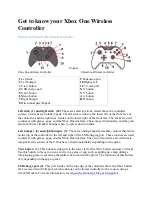
Using Broadcom Advanced Control Suite 4
NetXtreme
User Guide
Broadcom
®
April 2017 • 2CS57XX-CDUM514-R
Page 69
General Statistics
General Statistics show the transmitted and received statistics to and from the adapter.
Frames Tx OK.
A count of the frames that were successfully transmitted. This counter is incremented when the
transmit status is reported as Transmit OK.
Frames Rx OK.
A count of the frames that were successfully received. This does not include frames received
with frame-too-long, frame check sequence (FCS), length, or alignment errors, nor frames lost due to internal
MAC sublayer errors. This counter is incremented when the receive status is reported as Receive OK.
Directed Frames Tx.
A count of directed data frames that were successfully transmitted.
Multicast Frames Tx.
A count of frames that were successfully transmitted (as indicated by the status value
Transmit OK) to a group destination address other than a broadcast address.
Broadcast Frames Tx.
A count of frames that were successfully transmitted (as indicated by the transmit status
Transmit OK) to the broadcast address. Frames transmitted to multicast addresses are not broadcast frames
and are excluded.
Directed Frames Rx.
A count of directed data frames that were successfully received.
Multicast Frames Rx.
A count of frames that were successfully received and are directed to an active
nonbroadcast group address. This does not include frames received with frame-too-long, FCS, length, or
alignment errors, nor frames lost because of internal MAC sublayer errors. This counter is incremented as
indicated by the Receive OK status.
Broadcast Frames Rx.
A count of frames that were successfully received and are directed to a broadcast group
address. This count does not include frames received with frame-too-long, FCS, length, or alignment errors, nor
frames lost because of internal MAC sublayer errors. This counter is incremented as indicated by the Receive
OK status.
Frames Rx with CRC Error.
The number of frames received with CRC errors.
Configuring Teaming
The teaming function allows you to group any available network adapters together to function as a team.
Teaming is a method of creating a virtual NIC (a group of multiple adapters that functions as a single adapter).
The benefit of this approach is that it enables load balancing and failover. Teaming is done through the
Broadcom Advanced Server Program (BASP) software. For a comprehensive description of the technology and
implementation considerations of the teaming software, refer to the "Broadcom Gigabit Ethernet Teaming
Services" section of your Broadcom network adapter user guide.
Teaming can be accomplished by either of the following methods:
•
Using the Broadcom Teaming Wizard
•
Summary of Contents for NetXtreme BCM57 Series
Page 1: ...Broadcom NetXtreme BCM57XX User Guide Last revised April 2017 2CS57XX CDUM514 R...
Page 16: ...Functionality and Features NetXtreme User Guide Broadcom April 2017 2CS57XX CDUM514 R Page 16...
Page 169: ...Regulatory Information NetXtreme User Guide Broadcom April 2017 2CS57XX CDUM514 R Page 169...
Page 170: ...Regulatory Information NetXtreme User Guide Broadcom April 2017 2CS57XX CDUM514 R Page 170...
Page 171: ...Regulatory Information NetXtreme User Guide Broadcom April 2017 2CS57XX CDUM514 R Page 171...
















































